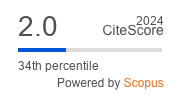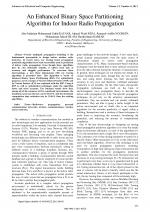| 4/2013 - 18 |
An Enhanced Binary Space Partitioning Algorithm for Indoor Radio PropagationKAUSAR, A. S. M. Z. |
| Extra paper information in |
| Click to see author's profile in |
| Download PDF |
Author keywords
radiowave propagation, personal communication networks, wireless communications, wireless sensor networks
References keywords
tracing(12), propagation(10), research(9), progress(9), electromagnetics(9), space(8), pier(8), prediction(6), optimization(6), indoor(6)
Blue keywords are present in both the references section and the paper title.
About this article
Date of Publication: 2013-11-30
Volume 13, Issue 4, Year 2013, On page(s): 103 - 110
ISSN: 1582-7445, e-ISSN: 1844-7600
Digital Object Identifier: 10.4316/AECE.2013.04018
Web of Science Accession Number: 000331461300018
SCOPUS ID: 84890200621
Abstract
Precise multipath propagation modeling is the fundamental prerequisite to design indoor wireless radio networks. In recent years, ray tracing based propagation prediction algorithms have been successfully used in prediction of indoor radio propagation. Even though these algorithms have its own noticeable benefits, it suffers from lack of accuracy and sluggish performance. To overcome these shortcomings, a new three dimensional (3D) ray tracing algorithm is presented here. This algorithm is based on balanced Binary Space Partitioning (BSP). For optimization purposes, novel concepts of Nearest Object Priority (NOP) and In Contact Surface (ICS) are combined with this BSP. Using of BSP as well as optimization techniques make the algorithm faster and more accurate. The obtained results show that, among all of the scenarios of five considered environments, the maximum accuracy increase can be 87.27% and the maximum computation time reduction can be 33.60% than the existing algorithms. |
| References | | | Cited By «-- Click to see who has cited this paper |
| [1] M. F. Iskander, Y. Zhengqing, "Propagation prediction models for wireless communication systems," IEEE Transaction on Microwave Theory and Techniques, vol. 50, no. 3, pp. 662-673, 2002. [CrossRef] [SCOPUS Times Cited 411] [2] T. K. Sarkar, Ji. Zhong, K. Kyungjung, A. Medouri, M. Salazar-Palma, "A survey of various propagation models for mobile communication," IEEE Antennas and Propagation Magazine, vol. 45, no. 3, pp. 51-82, 2003. [CrossRef] [SCOPUS Times Cited 769] [3] N. Yarkony, N. Blaunstein, "Prediction of propagation characteristics in indoor radio communication environments," Progress In Electromagnetics Research, vol. 59, 151-174, 2006. [CrossRef] [SCOPUS Times Cited 57] [4] M. S. Sarker, A. W. Reza, K. Dimyati, "A novel ray -tracing technique for indoor radio signal prediction," Journal of Electromagnetic Waves and Application, vol. 25, pp. 1179-1190, 2011. [CrossRef] [SCOPUS Times Cited 21] [5] C. H. Liang, Z.-L. Liu, H. Di, "Study on the blockage of electromagnetic rays analytically," Progress In Electromagnetics Research B, vol. 1, pp. 253-168, 2008. [CrossRef] [6] A. Tayebi, J. Gomez, F. M. Saez de Adana, O. Gutierrez, "The application of ray-tracing to mobile localization using the direction of arrival and received signal strength in multipath indoor environments," Progress In Electromagnetics Research, vol. 91, pp. 1-15,2009. [CrossRef] [SCOPUS Times Cited 83] [7] H. Kim, H.-S. Lee, "Accelerated three dimensional ray tracing techniques using ray frustums for wireless propagation models," Progress In Electromagnetics Research, vol. 96, pp. 21-36, 2009. [CrossRef] [SCOPUS Times Cited 23] [8] A. W. Reza, M. S. Sarker, K. Dimyati, "A novel integrated mathematical approach of ray-tracing and genetic algorithm for optimizing indoor wireless coverage," Progress In Electromagnetics Research, vol. 110, pp. 147-162, 2010. [CrossRef] [SCOPUS Times Cited 31] [9] C. H. Teh, F. Kung, H. T. Chuah, "A path-corrected wall model for ray-tracing propagation modeling," Journal of Electromagnetic Waves and Applications, vol. 20, no. 2, pp. 207-214, 2006. [CrossRef] [SCOPUS Times Cited 13] [10] C. Wang, M. T. Thai, Y. Li, F. Wang, W. Wu, "Optimization scheme for sensor coverage scheduling with bandwidth constraints," Optimization Letters, vol. 3, no. 1, pp. 63-75, 2009. [CrossRef] [SCOPUS Times Cited 25] [11] A. W. Reza, K. Dimyati, K. A. Noordin, A. S. M. Z. Kausar, M. S. Sarker, "A comprehensive study of optimization algorithm for wireless coverage in indoor area," Optimization Letters, 2012. [CrossRef] [SCOPUS Times Cited 11] [12] Y. B. Tao, H. Lin, H. J. Bao, "Kd-tree based fast ray tracing for RCS prediction," Progress In Electromagnetics Research, vol. 81, pp. 329-341, 2008. [CrossRef] [SCOPUS Times Cited 129] [13] J.-K. Bang, B.-C. Kim, "Time consumption reduction of ray tracing for RCS prediction using efficient grid division and space division algorithms," Journal of Electromagnetic Waves and Applications, vol. 21, no. 6, pp. 829-841, 2007. [CrossRef] [SCOPUS Times Cited 50] [14] K. S. Jin, "Fast ray tracing using a space-division algorithm for RCS prediction," Journal of Electromagnetic Waves and Applications, vol. 21, no. 1, pp. 119-126, 2006. [CrossRef] [SCOPUS Times Cited 90] [15] N. S. Alvar, A. Ghorbani, H. R. Amindavar, "A novel hybrid approach to ray tracing acceleration based on pre-processing & bounding volumes," Progress In Electromagnetics Research, vol. 82, pp. 19-32, 2008. [CrossRef] [SCOPUS Times Cited 19] [16] V. Mohtashami, A. A. Shishegar, "Modified wavefront decomposition method for fast and accurate ray-tracing simulation," IET Microwaves, Antennas & Propagation, vol. 6, no.3, pp. 293-304, 2012. [CrossRef] [SCOPUS Times Cited 27] [17] Y. Zhengqing, M.F. Iskander, Z. Zhijun, "Fast ray tracing procedure using space division with uniform rectangular grid," Electronics Letters, vol. 36, no. 10, pp. 895-897, 2000. [CrossRef] [SCOPUS Times Cited 43] [18] Y. Cocheril, R. Vauzelle, "A new ray-tracing based wave propagation model including rough surfaces scattering," Progress In Electromagnetics Research, vol. 75, pp. 357-381, 2007. [CrossRef] [SCOPUS Times Cited 65] [19] M. Thiel, K. Sarabandi, "A hybrid method for indoor wave propagation modeling," IEEE Transactions on Antennas and Propagation, vol. 56, no. 8, pp. 2703-2709, 2008. [CrossRef] [SCOPUS Times Cited 49] [20] A. W. Reza, S. M. Pillai, K. Dimyati, K. G. Tan, "A novel positioning system utilizing zigzag mobility pattern," Progress In Electromagnetics Research, vol. 106, pp. 263-278, 2010. [CrossRef] [SCOPUS Times Cited 7] [21] A. W. Reza, T. W. Yun, K. Dimyati, K. G. Tan, K. A. Noordin, "Deployment of a 3D tag tracking method utilizing RFID," International Journal of Electronics, vol. 99, no. 4, pp. 557-573, 2011. [CrossRef] [SCOPUS Times Cited 3] [22] H. Kwon, D. J. Pack, "Cooperative target localization by multiple unmanned aircraft systems using sensor fusion quality," Optimization Letters, vol. 6, no. 8, pp. 1707-1717, 2012. [CrossRef] [SCOPUS Times Cited 9] [23] C. K. Chow, S. Y. Yuen, "A multiobjective evolutionary algorithm that diversifies population by its density," IEEE Trans. on Evolutionary Computation, vol. 16, no. 2, pp. 149-172, 2012. [CrossRef] [SCOPUS Times Cited 56] [24] A. Dumitrescu, J. S. B. Mitchell, M. Sharir, "Binary space partitions for axis-parallel segments, rectangles, and hyperrectangles," Discrete & Computational Geometry, vol. 31, no. 2, pp. 207-227, 2004. [CrossRef] [SCOPUS Times Cited 24] [25] H. Radha, M. Vetterli, R. Leonardi, "Image compression using binary space partitioning trees," IEEE Trans. on Image Processing, vol. 5, no. 12, pp. 1610 - 1624, 1996. [CrossRef] [SCOPUS Times Cited 59] [26] C. D. Toth, "Binary space partitions : recent developments," Combinatorial and Computational Geometry, MSRI Publication, vol. 52, pp. 529-555, 2005. [27] Z. Lining, W. Lipo, L. Weisi, "Generalized biased discriminant analysis for content-based image retrieval," IEEE Trans. on Systems, Man, and Cybernetics, Part B: Cybernetics, vol. 42, no. 1, pp. 282-290, 2012. [CrossRef] [SCOPUS Times Cited 63] [28] M. de Berg, M. M. de Groot, M. H. Overmars, "Perfect binary space partitions," Computational Geometry: Theory and Applications, vol. 7, no. 1-2, pp. 81-91, 1997. [CrossRef] [SCOPUS Times Cited 23] [29] G. S. Alijani, R. Krishnaswamy, "On constructing binary space partitioning trees," ACM Annual of Computer Science Proceedings, vol. 18, pp. 230-235, 1990. [30] B.Chazelle, "Filtering search: A new approach to Query-Answering," SIAM Journal of Computing, vol. 15, pp. 703-724, 1986. [CrossRef] [SCOPUS Times Cited 239] [31] M. I. Shamos, F. P. Preparata, Computational Geometry: An Introduction, Springer-Verlag, New York, 1985. [32] T. P. Humphreys, A Reference Guide to Vector Algebra, Jain Pub Co; Pap/Cdr Edition, Fremont, CA, 2010. [33] M. Carvalho, A.S., V. Boginski, B. Balasundaram, "Topology design for on-demand dual-path routing in wireless networks," Optimization Letters, [CrossRef] [34] C. Xu, D. Schonfeld, A. A. Khokhar, "Localization and Trajectory Estimation of Mobile Objects Using Minimum Samples," IEEE Trans. on Vehicular Technology, vol. 58, no. 8, pp. 4439-4446, 2009. [CrossRef] [SCOPUS Times Cited 7] Web of Science® Citations for all references: 0 SCOPUS® Citations for all references: 2,406 TCR Web of Science® Average Citations per reference: 0 SCOPUS® Average Citations per reference: 65 ACR TCR = Total Citations for References / ACR = Average Citations per Reference We introduced in 2010 - for the first time in scientific publishing, the term "References Weight", as a quantitative indication of the quality ... Read more Citations for references updated on 2025-07-01 19:38 in 198 seconds. Note1: Web of Science® is a registered trademark of Clarivate Analytics. Note2: SCOPUS® is a registered trademark of Elsevier B.V. Disclaimer: All queries to the respective databases were made by using the DOI record of every reference (where available). Due to technical problems beyond our control, the information is not always accurate. Please use the CrossRef link to visit the respective publisher site. |
Faculty of Electrical Engineering and Computer Science
Stefan cel Mare University of Suceava, Romania
All rights reserved: Advances in Electrical and Computer Engineering is a registered trademark of the Stefan cel Mare University of Suceava. No part of this publication may be reproduced, stored in a retrieval system, photocopied, recorded or archived, without the written permission from the Editor. When authors submit their papers for publication, they agree that the copyright for their article be transferred to the Faculty of Electrical Engineering and Computer Science, Stefan cel Mare University of Suceava, Romania, if and only if the articles are accepted for publication. The copyright covers the exclusive rights to reproduce and distribute the article, including reprints and translations.
Permission for other use: The copyright owner's consent does not extend to copying for general distribution, for promotion, for creating new works, or for resale. Specific written permission must be obtained from the Editor for such copying. Direct linking to files hosted on this website is strictly prohibited.
Disclaimer: Whilst every effort is made by the publishers and editorial board to see that no inaccurate or misleading data, opinions or statements appear in this journal, they wish to make it clear that all information and opinions formulated in the articles, as well as linguistic accuracy, are the sole responsibility of the author.



